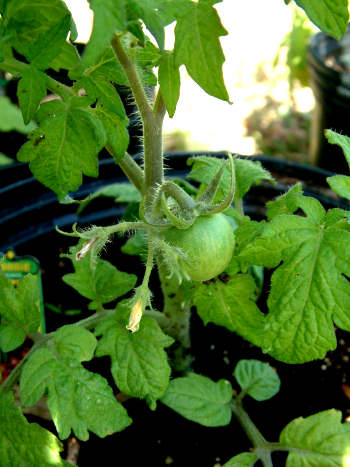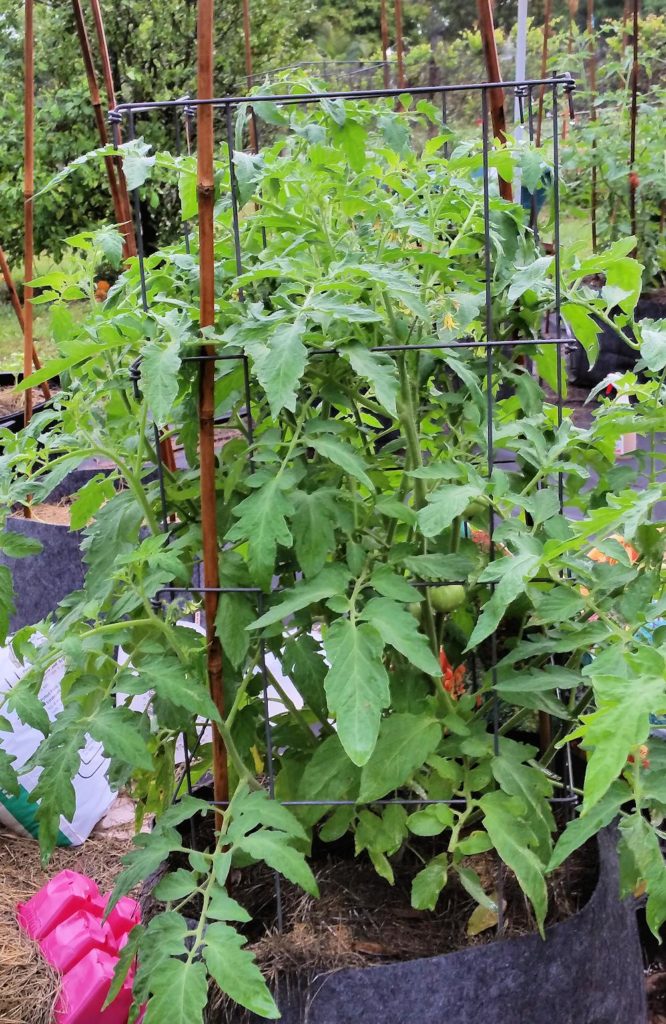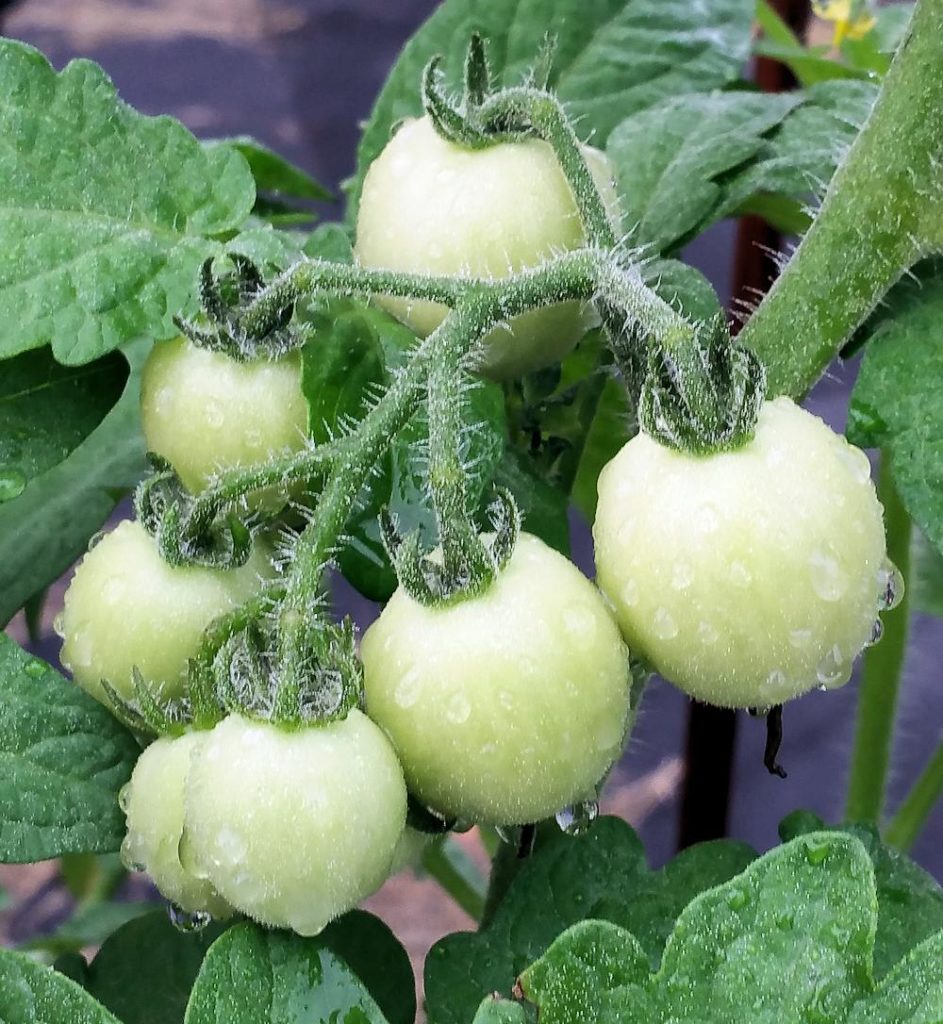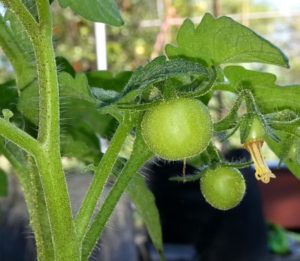Growing Tomatoes
Planting a Tomato Garden
Are you thinking about planting a tomato garden? It’s just before Christmas as I write this, but no matter where you live, it’s time to think tomatoes!
If you live in the (really) Deep South, it’s time to plant seeds soon for a Spring crop. If you live in the frigid North, it’s time to buy those seeds for starting in just a few short months.
Yep, it’s time to think tomatoes!
Planting a Tomato Garden in the South
If you live in the really southern part of the US (like I do in S Florida), you can plant your seeds soon (even right now) or even find tomato plants at your local garden center. I planted a bunch of seeds yesterday, in preparation of a Spring crop of ripe tomatoes. But since it still can get chilly and I can even have a touch of frost where I live, I plant my tomatoes in containers. This way, if frost is in the forecast, I can move the plants into the garage for the night.
Right now I have three tomato plants of three different varieties in 5-gallon pots, one having blossoms. Seeing as it’s Winter, I have them in a spot where they can get full sunlight from about 11 am to 4 pm. I also have six more tomato seed varieties that I planted yesterday. Right now, my well-grown plants are:
- A determinate red medium-sized tomato (the one with flowers) called Patio – photo above.
- An indeterminate bicolor tomato called Mr. Stripey.
- An indeterminate really big red beefsteak tomato called Park’s Whopper.
So, if you live in the Deep South, it’s time to start your tomato seeds indoors between now and the end of January (depending on how far north on the Deep South you live). The seedlings can then be transplanted outside as soon as all danger of frost is past. You can find tomato seeds in local garden centers as well as online. I have to admit, online is my favorite way to get seeds.
A special note to anyone like me who lives in Florida; as you well know, our summers are hot & humid and the sunshine very strong. Summer in Florida really isn’t the best time of year to grow tomatoes. I’ll cover more about tomato-growing in the summer in Florida in a different post.
USDA Plant Hardiness Zones
No matter where you live, know what plant hardiness zone you live in. Here’s a link to where you can put in your zip code, and you’ll get your zone.
Like I said, local climate plays into this. You can live in the Mid South, but if you are gardening at altitude (like around the Smokey Mountains), your zone will be colder than if you were growing in a more coastal environment.
Tomato Gardens in the North
Time to get those seeds! Since you won’t be planting them right away, you have a little time to peruse your tomato variety options a bit more. You probably don’t have seeds available in garden centers yet, but you can browse and order them online.
So what seeds do you buy? It really depends on your climate, and how long and warm your summers. For example, in the Pacific Northwest, I’d choose a tomato that sets fruit early. The cooler Summer climate means it will take longer than average to grow those tomatoes until they are ripe on the vine, which is why you need an early-producing tomato. Some varieties you could try include Early Girl, Matina, Stupice, Early Wonder.
If you live in a climate with a pretty warm and sunny late Spring and Summer, you can grow both early and mid-season varieties. You can try a later-season beefsteak if you can grow your tomatoes in a greenhouse or indoors under grow lights and have good-sized plants ready to go outside as soon as the last frost is past. Some mid-season tomatoes varieties to think about include Better Boy, Big Beef, Eva Purple Ball, Sioux.
So those are some ideas for your tomato garden. It’s time to either plant seeds or buy seeds, so you can have luscious, vine ripe tomatoes as soon as possible!
Tomato Growth Requirements
It’s time to learn about tomato growth requirements — what they like, in order to grow best. While individual varieties may be better for warmer or cooler climates than you average tomato, you still need to know the basics.
With that thought in mind, here are the basic requirements for growing tomatoes.
Tomato Growth Requirements
Like most fruits and vegetables, tomatoes require at least 6 hours or direct sunlight a day. If you live in a super-sunny and hot location, your tomato plants might appreciate some dappled shade in the afternoons, to help prevent against both wilting and sunscald.
Tomatoes also require warm weather — frost will kill them. The ideal temperatures for most (not all!) tomatoes is the mid 70’s to low 80’s during the day, with nights in the mid 50s to mid 60’s. (Temperatures in degrees Fahrenheit.)
In an ideal climate, there should be a 15 to 20 degree difference between day and night temperatures. However, when the nighttime lows are routinely in the 70s, the plants might not get enough of a cool-down to set fruits well.
However, tomatoes will grow and set fruit in warmer weather, as well as in cooler weather; they just won’t be quite as productive. Keep your local temperatures in mind when selecting tomato varieties.
For example, a grower in the cool Pacific Northwest would be better off with early tomatoes (those that mature in 67 days or less), as well as tomatoes that are bred for cooler weather. On the other hand, someone in the desert Southwest would be well-advised to select tomatoes that have a good track record of bearing fruit in hot weather.
 So, keep your local climate in mind when selecting tomato varieties. Oh, and an adequate water supply is essential for tomatoes to produce fruits; an average of an inch of water per week is considered optimal, but if you live in a dry climate, you might want to provide a bit more; tomatoes can get thirsty!
So, keep your local climate in mind when selecting tomato varieties. Oh, and an adequate water supply is essential for tomatoes to produce fruits; an average of an inch of water per week is considered optimal, but if you live in a dry climate, you might want to provide a bit more; tomatoes can get thirsty!
And if you live in a hot and humid climate, like the Southeast — be especially careful with your fertilizing schedule, and know the tomato diseases that thrive in a hot, humid environment.
Fertilizing Tomato Plants
Fertilizing tomato plants is necessary for optimum growth (both for the plants and the tomatoes). But is there a best way to fertilize? And what about organic fertilizers versus chemical?
Let’s take a look at feeding your tomato plants.
Fertilizing Tomato Plants Organically
Organic fertilizers tend to break down slowly, releasing their nutrients into the soil over time. By “feeding the soil” the plants become stronger and less prone to attack from insects and disease. A good organic approach would be to use a combination of compost, peat, aged manure (or the bagged varieties from the store), and organic amendments such as blood meal and bone meal to create a rich soil.
With this approach, additional fertilizer is usually only necessary only once or twice a season; just after the blossoms appear, and again when a plant is laden with fruit. Good organic fertilizers for this use include fish emulsion, seaweed emulsion, and “manure tea” (fresh manure placed in a large container, filled with water, and allowed to “steep” for about a week). Make sure to dilute any such liquid fertilizer until it is the color of weak tea; even organic fertilizers can “fry” plants if applied too strong!
The organic method of gardening also benefits the environment by not adding chemicals that can upset the balance of nature. We’ve all read about how these chemicals can harm wildlife, not to mention ourselves when they infiltrate the water system. Chemical fertilizers work quickly, but they also leach out of the soil quickly.
Using Chemical Fertilizers
Having made the pitch for the organic method, I realize that not everyone is comfortable using organic methods yet. I do urge you to give the matter some thought, but if you much use chemical fertilizers, here are some general rules:
Fertilizer strength is measured by the percentage of nitrogen, phosphorus and potassium (N-P-K) to inert ingredients. For example, 6-6-6 means there is 6 lbs. of nitrogen, 6 lbs. of phosphorus and 6 lbs. of potassium per 100 lbs of fertilizer. A mixture of 4-12-6 would mean 4 lbs. of nitrogen, 12 of phosphorus and 6 of potassium per 100 lbs.
Look for fertilizers with a higher phosphorus (middle) number. Phosphorus is what fuels the production of flowers, and flowers are how fruits are formed. Try to make it a relatively balanced mix (5-10-5 would be ok, 5-10-8 would be better). You might try Miracle Grow for Roses (you read that right, roses), and use it at 3/4 strength.
Don’t use a “bloom booster” fertilizer with a super-high phosphorus count and really low on nitrogen and potassium. You might be favoring blooms, but your tomatoes may fail to develop properly later on, because the leaves and roots didn’t get enough of what they need.
Do not use a high nitrogen fertilizer! You’ll be sacrificing fruits for leaf growth!
Do not fall into the trap of thinking “If a little fertilizer is good, more is even better!” Wrong! Too much fertilizer can kill the plants. It’s much better to use the fertilizer at 1/2 strength and fertilize a little more often.
Organic + Chemical
Yes, you can mix organic and chemical fertilizers, and in fact I often do. I amend my soil with plenty of compost & manure, then add kelp meal, bone meal and blood meal. A little fish and/or seaweed emulsion finishes it off.
However, I like to add some of the Miracle Grow for Roses (2/3 strength) at the time the blossoms are starting to open, just to give the plants a little extra “snack”. I might give a little extra (1/2 strength) if the plants have a heavy tomato load.
That’s what I do — you are free to use whatever fertilizers you’d like, for your own circumstances.
Additional Reading
Now that you’ve learned about fertilizers, you might want to know about tomato insects and tomato diseases. Be prepared!
Tomato Growing Questions
Ok, tomato fun facts aside, you may have some additional tomato growing questions. Here are a few of the most common questions, with links to more detailed answers.
Before we go on to the growing questions, though, here’s a question that has plagued people for years: are tomatoes fruits or vegetables?
Botanically, tomatoes are fruits; however, as far as use, tomatoes are classed as vegetables. How come? At one point, the US government was levying a tax on imported vegetables, and tomatoes became an issue — fruit or vegetable? The final decree was “If it’s most often eaten as a part of a meal (salad or mail course), it’s a vegetable. If it’s most often eaten as a dessert, its a fruit.”
Tomato Growing Questions
Are tomatoes easy to grow? For the most part, yes! Most tomato varieties will grow and produce delicious fruits for you. If you have a short gro wing season or lots of cloudy days, however, you should stick with the early and possibly mid season fruits (stay away from the huge beefsteaks — they won’t have time to ripen). If you have a longer growing season with plenty of sunshine, you can grow almost any variety. Caveat; most tomatoes don’t like really hot and humid weather (although some varieties do OK in the heat & humidity).
wing season or lots of cloudy days, however, you should stick with the early and possibly mid season fruits (stay away from the huge beefsteaks — they won’t have time to ripen). If you have a longer growing season with plenty of sunshine, you can grow almost any variety. Caveat; most tomatoes don’t like really hot and humid weather (although some varieties do OK in the heat & humidity).
So how do I grow tomatoes? Here’s some tomato growing requirements on how to grow those great-tasting tomatoes!
Should I get plants from a garden center or start from seeds? This one will depend on your circumstances. If you are late for starting seeds, or you just don’t want to go the seed route, buying a plant from a gardening center is great. Just keep in mind that there usually isn’t a huge variety, although mostly they are varieties that will grow fine in your area. When it comes to seeds, the sky is the limit! You can grow all kinds, and experimenting can be fun. It’s also less expensive overall than buying plants. (I’ve had tomato seeds 5 and even 10 years old and still germinate.)
What kind of insects or diseases do I need to know about? Here is the lowdown on insects and diseases that could come to visit your tomatoes — and possible solutions!!
What kind of fertilizer should I use? You can use organic, chemical or a mixture of both. Check out the tomato fertilizer page for information about the different kinds.
Can I grow tomatoes is a greenhouse? Sure! The key to deciding the varieties that would be best are 1) the size of your greenhouse and 2) the warmth and sunlight your greenhouse receives. Your best bets may be determinate tomatoes, cherry tomatoes, and heart-shaped tomatoes (but any kinds are possible, depending on how big your greenhouse is).
When should I plant tomatoes? It really depends on your climate! For example, in South Florida, early Fall, late Winter and Spring are our prime tomato-growing times. For most of the country, Summer is the prime growing season. Here’s a general rule of thumb; start your seeds indoors at 4 to 6 weeks before your last expected frost — then transplant to the garden 1 week after the last expected frost (you can go a little earlier with protection).
It’s Fall, frost is coming, and my plants still have unripe tomatoes! Can I ripen these tomatoes indoors? You’ll probably be able to ripen some to even most of your tomatoes that are still on the vine; here are some tips. If you have the space, you can pull up the entire tomato plant(s) and hang them upside-down in a cool dark place. As the tomatoes ripen, pull them off the vine and enjoy! If you don’t have that kind of space, pluck the tomatoes that are farthest along, and wrap them loosely in some newspaper. Store the tomatoes in a cool dark place, in a single layer. Check the tomatoes periodically, and use those that are ripe.
Got more questions? Check out the tomato growing terms page!